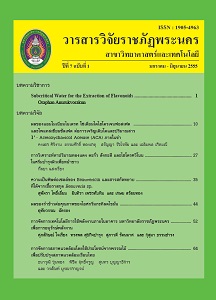การวิเคราะห์หาปริมาณทองแดง ตะกั่ว สังกะสี และไฮโดรควิโนน ในครีมบำรุงผิวเพื่อหน้าขาว
Keywords:
ครีมบำรุงผิวเพื่อหน้าขาว, ตะกั่ว, ทองแดง, สังกะสี, ไฮโดรควิโนน, Whitening facial creams, Copper, Lead, Zinc, HydroquinoneAbstract
ในปัจจุบันนี้ผู้บริโภคให้ความสำคัญต่อสุขภาพผิวหน้าเป็นอย่างมาก มีการเลือกใช้ครีมบำรุงผิว เพื่อหน้าขาวกันอย่างหลากหลาย งานวิจัยนี้ได้ทำการสำรวจเครื่องหมายการค้าของครีมบำรุงผิวเพื่อหน้าขาว ที่ตัวอย่างประชากรในจังหวัดนนทบุรี จำนวน 801 คน ใน 6 เขตพื้นที่ ได้แก่ อำเภอเมืองนนทบุรี บางกรวย บางใหญ่ บางบัวทอง ไทรน้อย และปากเกร็ด เลือกใช้ และนำครีมบำรุงผิวเพื่อหน้าขาวดังกล่าว พร้อมกับครีม ที่มีจำหน่ายทั่วไปในท้องตลาดในจังหวัดนนทบุรี รวมจำนวน 16 เครื่องหมายการค้า มาทำการวิเคราะห์ ปริมาณโลหะหนัก ได้แก่ ทองแดง ตะกั่ว และสังกะสี โดยวิธีเฟลมอะตอมมิกแอบซอร์พชันสเปกโทรเมตรี การวิเคราะห์พบว่า ครีมบำรุงผิวเพื่อหน้าขาวดังกล่าวมีปริมาณทองแดง ตะกั่ว และสังกะสีอยู่ในช่วง 0.49-594 ppm, 5.24-17.6 ppm และ 19.6-181000 ppm ตามลำดับ นอกจากนี้ ยังได้ทำการวิเคราะห์ ไฮโดรควิโนน แต่ไม่พบปริมาณของสารดังกล่าวในครีมตัวอย่าง ซึ่งบ่งชี้ได้ว่าครีมบำรุงผิวเพื่อหน้าขาวที่ กลุ่มตัวอย่างเลือกใช้และครีมที่มีจำหน่ายทั่วไปในท้องตลาดไม่เป็นอันตรายต่อสุขภาพตามข้อกำหนดของ กระทรวงสาธารณสุข
The Quantitative Determination of Copper, Lead, Zinc and Hydroquinone in Whitening Facial Creams
Recently, people pay significant attention to their facial skin care. There are many different facial whitening products available for them. Herein this work, total of 16 different whitening facial creams were chosen by 801 people living in six areas of Nonthaburi Province including Muang Nonthaburi, Bangkruai, Bangyai, Bangbuathong, Sainoi and Pakkred, and some other creams available in markets. The samples were analyzed to determine copper, lead, and zinc containing in such creams. Using the Flame Atomic Absorption Spectrometry (FAAS), the results showed that there are copper, lead, and zinc in whitening facial cream samples in the range of 0.49-594 ppm, 5.24-17.6 ppm, and 19.6-181000 ppm, respectively. In addition, hydroquinone was also investigated, but it was not found in any sample. The quantitative analysis results indicate that the popular whitening facial creams do not harm to human health according to a regulation of the Ministry of Public Health of Thailand.Downloads
Issue
Section
License
โปรดกรอกเอกสารและลงนาม "หนังสือรับรองให้ตีพิมพ์บทความในวารสารวิจัยมหาวิทยาลัยราชภัฏพระนคร สาขาวิทยาศาสตร์และเทคโนโลยี" ก่อนการตีพิมพ์




